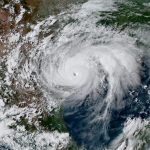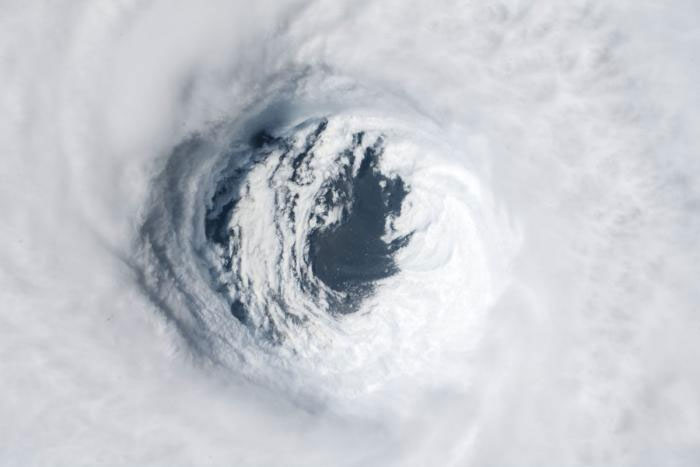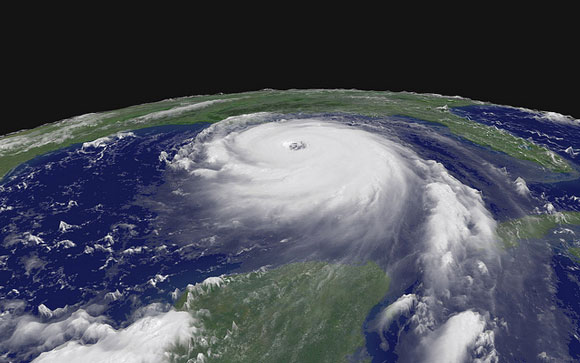

The Atlantic hurricane season begins on June 1 and ends November 30. This is Hurricane Florence, seen from the International Space Station (ISS) on the morning of September 12, 2018. Image via NASA.
Ever wonder how hurricanes get their names? And why do hurricanes have names at all? Meteorologists long ago learned that naming tropical storms and hurricanes helps people remember the storms, communicate about them more effectively, and so stay safer if and when a particular storm strikes a coast. These experts assign names to hurricanes according to a formal list of names that is approved before the start of each hurricane season. The U.S. National Hurricane Center started this practice in the early 1950s. Now, the World Meteorological Organization generates and maintains the list of hurricane names.
Here are the hurricane names for 2020:
Atlantic hurricane names (season runs from June 1 to November 30) are Arthur, Bertha, Cristobal, Dolly, Edouard, Fay, Gonzalo, Hanna, Isaias, Josephine, Kyle, Laura, Marco, Nana, Omar, Paulette, Rene, Sally, Teddy, Vicky, and Wilfred.
Eastern North Pacific hurricane names (season runs from May 15 to November 30) are Amanda, Boris, Cristina, Douglas, Elida, Fausto, Genevieve, Hernan, Iselle, Julio, Karina, Lowell, Marie, Norbert, Odalys, Polo, Rachel, Simon, Trudy, Vance, Winnie, Xavier, Yolanda, and Zeke. The eastern North Pacific hurricane .
If you’re interested, you can view those names, and names for upcoming years, here.

The eyewall of Hurricane Michael photographed on October 10, 2018, by astronauts onboard the International Space Station. Hurricane Michael was a category 5 storm when it made landfall in the vicinity of Mexico Beach, Florida, on October 10. Image via NASA.
How and why did hurricanes first begin receiving names? While people have been naming major storms for hundreds of years, most hurricanes were originally designated by a system of latitude-longitude numbers, which was useful to meteorologists trying to track these storms. Unfortunately, this system was confusing to people living on coasts seeking hurricane information.
In the early 1950s, a formal practice for storm naming was first developed for the Atlantic Ocean by the U.S. National Hurricane Center. At that time, storms were named according to a phonetic alphabet (e.g., Able, Baker, Charlie) and the names used were the same for each hurricane season; in other words, the first hurricane of a season was always named “Able,” the second “Baker,” and so on.
In 1953, to avoid the repetitive use of names, the system was revised so that storms would be given female names. By doing this, the National Weather Service was mimicking the habit of naval meteorologists, who named the storms after women, much as ships at sea were traditionally named for women.
In 1978–1979, the system was revised again to include both female and male hurricane names.
See the complete history of naming hurricanes, from NOAA
When does a storm receive a name? Tropical storms are given names when they display a rotating circulation pattern and wind speeds of 39 miles per hour (63 kilometers per hour). A tropical storm develops into a hurricane when wind speeds reach 74 mph (119 kph).
Lists of hurricane names have been developed for many of the major ocean basins around the world. Today, there are six lists of hurricane names in use for Atlantic Ocean and Eastern North Pacific storms. These lists rotate, one each year. That means the list of this year’s hurricane names for each basin will come up again six years from now. There’s an exception to this practice, however. The names of hurricanes that are particularly damaging are retired for legal, cultural sensitivity, and historical reasons. For example, the use of the name Katrina was retired in 2005 following the devastating impact that Hurricane Katrina had on New Orleans. In March 2019, the World Meteorological Organization removed the names Florence and Michael from its lists for the Atlantic Ocean basin and replaced the names with Francine and Milton. Hurricanes Florence and Michael, which respectively struck the coasts of North Carolina and Florida in 2018, each caused tremendous damage and dozens of fatalities.

Hurricane Katrina on August 28, 2005. Image via NASA.
The name Dorian of the category 5 hurricane that devastated the Bahamas in early September of 2019 is certain to be retired given the extensive fatalities (84 in total) and economic damages that it caused along its path. Dorian was in fact one of the strongest Atlantic hurricanes on record. However, the decision to retire the name by the World Meteorological Organization (WMO) in the spring of 2020 had to be postponed because of the current coronavirus panademic. The retirement of hurricane names for both the 2019 and 2020 seasons will be discussed jointly at next year’s hurricane committee meeting, according to a WMO spokesperson.
Bottom line: The naming of hurricanes helps people communicate about the storms more effectively. The World Meteorological Organization manages the formal system by which hurricanes receive their names. The names for each ocean basin are published in lists before the hurricane season.
Help EarthSky keep going! Please donate.
from EarthSky https://ift.tt/2ZGHQpK


The Atlantic hurricane season begins on June 1 and ends November 30. This is Hurricane Florence, seen from the International Space Station (ISS) on the morning of September 12, 2018. Image via NASA.
Ever wonder how hurricanes get their names? And why do hurricanes have names at all? Meteorologists long ago learned that naming tropical storms and hurricanes helps people remember the storms, communicate about them more effectively, and so stay safer if and when a particular storm strikes a coast. These experts assign names to hurricanes according to a formal list of names that is approved before the start of each hurricane season. The U.S. National Hurricane Center started this practice in the early 1950s. Now, the World Meteorological Organization generates and maintains the list of hurricane names.
Here are the hurricane names for 2020:
Atlantic hurricane names (season runs from June 1 to November 30) are Arthur, Bertha, Cristobal, Dolly, Edouard, Fay, Gonzalo, Hanna, Isaias, Josephine, Kyle, Laura, Marco, Nana, Omar, Paulette, Rene, Sally, Teddy, Vicky, and Wilfred.
Eastern North Pacific hurricane names (season runs from May 15 to November 30) are Amanda, Boris, Cristina, Douglas, Elida, Fausto, Genevieve, Hernan, Iselle, Julio, Karina, Lowell, Marie, Norbert, Odalys, Polo, Rachel, Simon, Trudy, Vance, Winnie, Xavier, Yolanda, and Zeke. The eastern North Pacific hurricane .
If you’re interested, you can view those names, and names for upcoming years, here.

The eyewall of Hurricane Michael photographed on October 10, 2018, by astronauts onboard the International Space Station. Hurricane Michael was a category 5 storm when it made landfall in the vicinity of Mexico Beach, Florida, on October 10. Image via NASA.
How and why did hurricanes first begin receiving names? While people have been naming major storms for hundreds of years, most hurricanes were originally designated by a system of latitude-longitude numbers, which was useful to meteorologists trying to track these storms. Unfortunately, this system was confusing to people living on coasts seeking hurricane information.
In the early 1950s, a formal practice for storm naming was first developed for the Atlantic Ocean by the U.S. National Hurricane Center. At that time, storms were named according to a phonetic alphabet (e.g., Able, Baker, Charlie) and the names used were the same for each hurricane season; in other words, the first hurricane of a season was always named “Able,” the second “Baker,” and so on.
In 1953, to avoid the repetitive use of names, the system was revised so that storms would be given female names. By doing this, the National Weather Service was mimicking the habit of naval meteorologists, who named the storms after women, much as ships at sea were traditionally named for women.
In 1978–1979, the system was revised again to include both female and male hurricane names.
See the complete history of naming hurricanes, from NOAA
When does a storm receive a name? Tropical storms are given names when they display a rotating circulation pattern and wind speeds of 39 miles per hour (63 kilometers per hour). A tropical storm develops into a hurricane when wind speeds reach 74 mph (119 kph).
Lists of hurricane names have been developed for many of the major ocean basins around the world. Today, there are six lists of hurricane names in use for Atlantic Ocean and Eastern North Pacific storms. These lists rotate, one each year. That means the list of this year’s hurricane names for each basin will come up again six years from now. There’s an exception to this practice, however. The names of hurricanes that are particularly damaging are retired for legal, cultural sensitivity, and historical reasons. For example, the use of the name Katrina was retired in 2005 following the devastating impact that Hurricane Katrina had on New Orleans. In March 2019, the World Meteorological Organization removed the names Florence and Michael from its lists for the Atlantic Ocean basin and replaced the names with Francine and Milton. Hurricanes Florence and Michael, which respectively struck the coasts of North Carolina and Florida in 2018, each caused tremendous damage and dozens of fatalities.

Hurricane Katrina on August 28, 2005. Image via NASA.
The name Dorian of the category 5 hurricane that devastated the Bahamas in early September of 2019 is certain to be retired given the extensive fatalities (84 in total) and economic damages that it caused along its path. Dorian was in fact one of the strongest Atlantic hurricanes on record. However, the decision to retire the name by the World Meteorological Organization (WMO) in the spring of 2020 had to be postponed because of the current coronavirus panademic. The retirement of hurricane names for both the 2019 and 2020 seasons will be discussed jointly at next year’s hurricane committee meeting, according to a WMO spokesperson.
Bottom line: The naming of hurricanes helps people communicate about the storms more effectively. The World Meteorological Organization manages the formal system by which hurricanes receive their names. The names for each ocean basin are published in lists before the hurricane season.
Help EarthSky keep going! Please donate.
from EarthSky https://ift.tt/2ZGHQpK


Aucun commentaire:
Enregistrer un commentaire